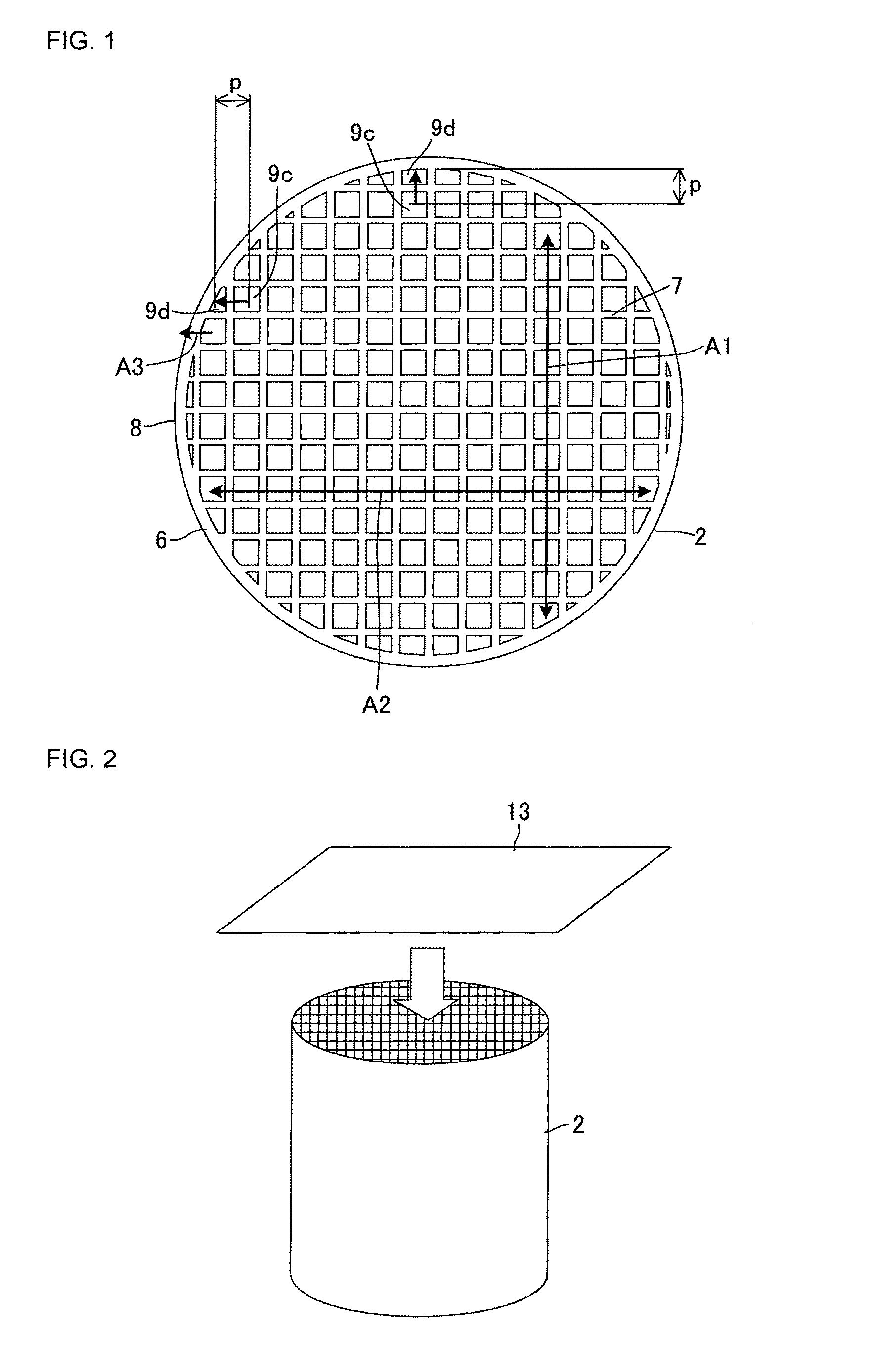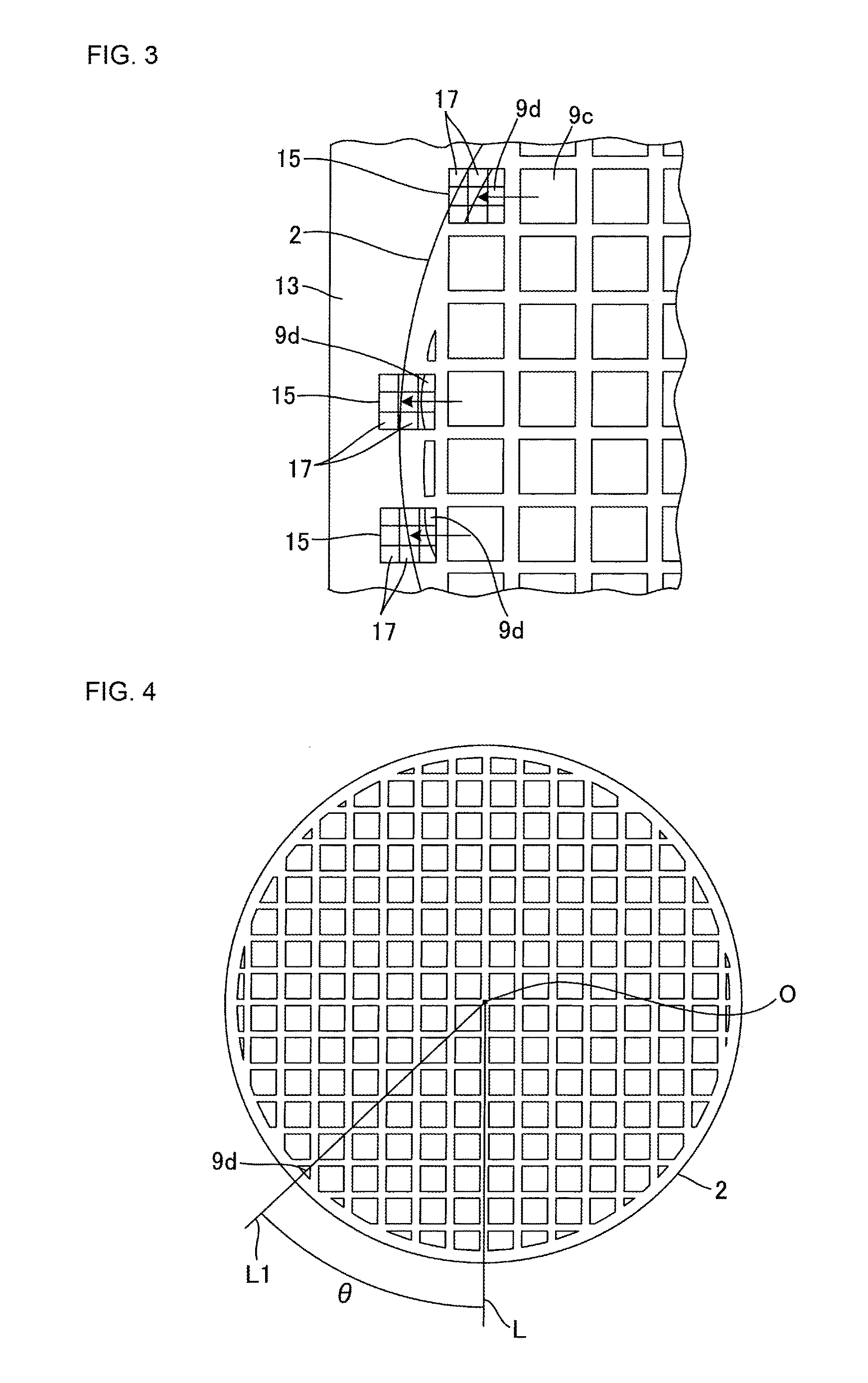Method for producing plugged honeycomb structure
- Summary
- Abstract
- Description
- Claims
- Application Information
AI Technical Summary
Benefits of technology
Problems solved by technology
Method used
Image
Examples
example 1
[0064]A commercially available transparent adhesive sheet was attached to an end face of a porous honeycomb structure made of cordierite. In the honeycomb structure, there was used a honeycomb structure in which a length was 150 mm, an outer diameter was 140 mm, a partition wall thickness was 300 μm, a cell shape (a shape of a usual cell) was square, a cell density was 300 cpsi (46.5 cells / cm2), and a designed cell pitch was 1.5 mm. The end face of the honeycomb structure to which the adhesive sheet was attached was imaged with a CCD camera, to subject an obtained image to image processing (binarization processing), and in a case where a black image of one block in the processed image reached 80% or more of a cell area of predetermined design, the image was regarded as the usual cell, to recognize a position of the cell. Additionally, an image resolution of the image processing was set to 0.06 mm / pixel. Furthermore, an average cell pitch was calculated from the usual cells whose pos...
example 2
[0065]The procedure of Example 1 was repeated to perform recognition of positions of usual cells and outermost circumferential cells, perforation processing to a sheet and formation of plugging portions, except that a honeycomb structure of a different structure was used. Afterward, it was checked whether or not a plugging slurry adhered to an inner peripheral surface of another cell adjacent to the outermost circumferential cell to be plugged and a circumferential wall of the honeycomb structure, and Table 1 shows the result. Additionally, in the honeycomb structure, there was used a honeycomb structure in which a length was 300 mm, an outer diameter was 300 mm, a partition wall thickness was 300 μm, a cell shape (a shape of the usual cell) was square, a cell density was 200 cpsi (31 cells / cm2), and a designed cell pitch was 1.8 mm.
example 3
[0066]The procedure of Example 1 was repeated to perform recognition of positions of usual cells and outermost circumferential cells, perforation processing to a sheet and formation of plugging portions, except that a honeycomb structure of a different structure was used. Afterward, it was checked whether or not a plugging slurry adhered to an inner peripheral surface of another cell adjacent to the outermost circumferential cell to be plugged and a circumferential wall of the honeycomb structure, and Table 1 shows the result. Additionally, in the honeycomb structure, there was used a honeycomb structure in which a length was 230 mm, an outer diameter was 230 mm, a partition wall thickness was 300 μm, a cell shape (a shape of the usual cell) was square, a cell density was 100 cpsi (15.5 cells / cm2), and a designed cell pitch was 2.5 mm.
PUM
| Property | Measurement | Unit |
|---|---|---|
| Circumference | aaaaa | aaaaa |
Abstract
Description
Claims
Application Information
 Login to View More
Login to View More - R&D
- Intellectual Property
- Life Sciences
- Materials
- Tech Scout
- Unparalleled Data Quality
- Higher Quality Content
- 60% Fewer Hallucinations
Browse by: Latest US Patents, China's latest patents, Technical Efficacy Thesaurus, Application Domain, Technology Topic, Popular Technical Reports.
© 2025 PatSnap. All rights reserved.Legal|Privacy policy|Modern Slavery Act Transparency Statement|Sitemap|About US| Contact US: help@patsnap.com



